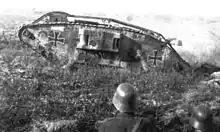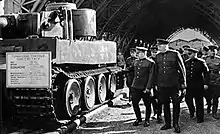Beutepanzer
Beutepanzer (German, lit. 'Captured Tank')[1] is the German designation for a captured armored fighting vehicle. The Germans used Beutepanzers to gain insight into enemy technology and to augment its own armored forces.

Beutepanzers were usually repainted to sport distinctive national emblems and unit insignia in order to reduce friendly fire from other Axis forces.
First World War
During World War I, the Germans had many Beutepanzers in their arsenal, far exceeding the production of their own tanks. Beutepanzers were given a German national cross and new camouflage. By the end of the war, a total of 170 Beutepanzers were still in running condition with 35 reported to be battle ready. In comparison, over a third of the 20 A7V tanks built by Germany had been destroyed or captured by then.
Second World War


Beutepanzers played an important role in the Wehrmacht.[2] After the Anschluss of Austria in 1938, many Czech tanks were claimed. In October 1940, the Heeresamt ordered two of each Beutepanzer type to be delivered to the Army Weapons Office for evaluation. Beutepanzers were used by the German Army on all fronts.
During the Western Campaign, Germany had captured 691 British tanks in total with an estimate of 350 being reusable. Most Beutepanzers captured during the campaign were modified into observation tanks or ammunition transports. Heavily damaged units were salvaged for spare parts. Additionally, roughly 1,800 modern (non-FT-17s) French tanks were captured during the May-June campaign and returned to service as Beutepanzers, alongside a similar number destroyed beyond repair.[3]
The Germans were able to secure some T-26 & BT Tanks[4] on the Eastern Front from 1941 to 1942. During 1943 the Germans started producing their own T-34[5] tanks in captured Soviet production plants, designated T-34 747(r) or Panzerkampfwagen 747(r).[5] However, because the tanks were not captured, they are not always classified as Beutepanzers.
The Germans were not the only users of captured tanks, though other nations didn't usually deploy captured vehicles for combat duty. The British were able to secure a Tiger 1 near Tunis in April 1943 (Tiger 131), and the Soviets soon captured a Tiger 1 tank thereafter.
| Beutepanzer | Original Tank | Captured From |
|---|---|---|
| Sturmgeschütz III | Nazi Germany | |
| T-5 | Panzerkampfwagen V Panther | Nazi Germany |
| T-IV | Panzerkampfwagen IV | Nazi Germany |
| T-III | Panzerkampfwagen III | Nazi Germany |
| LT-38 Praga | Panzerkampfwagen 38 (t) | Nazi Germany |
| T-1 | Panzerkampfwagen 1 | Nazi Germany |
| Beutepanzer | Captured From |
|---|---|
| BT-7 | Soviet Union |
| T-26 | Soviet Union |
| T-28 | Soviet Union |
| Beutepanzer | Captured From |
|---|---|
| T-40 | Soviet Union |
References
- "dict.cc dictionary :: Beutepanzer :: German-English translation". www.dict.cc. Retrieved 2018-08-03.
- Budanovic, Nikola (2016-07-02). "Beutepanzer, How Nazi Germany Relied on Captured Military Vehicles To Continue The Fight". WAR HISTORY ONLINE. Retrieved 2018-08-03.
- Garraud, Philippe (April 2004). "LE RÔLE DE LA " DOCTRINE DÉFENSIVE " DANS LA DÉFAITE DE 1940: une explication trop simple et partielle". Guerres Mondiales et Conflits Contemporains (in French) (214): 97–123. JSTOR 25732954.
- "Russische Beutepanzer | Beutepanzer | Panzer". archive.is. 2013-02-12. Retrieved 2018-08-03.
- "Panzerkampfwagen T 34 - 747(r)The Soviet T-34 Tank as Beutepanzer and Panzerattrappe in German Wehrmacht Service 1941-45 - TANKOGRAD Publishing - Verlag Jochen Vollert - Militärfahrzeug". www.tankograd.com. Retrieved 2018-08-03.
- "Škoda CKD Lt vz.35". www.tanks-encyclopedia.com. Retrieved 2018-08-03.